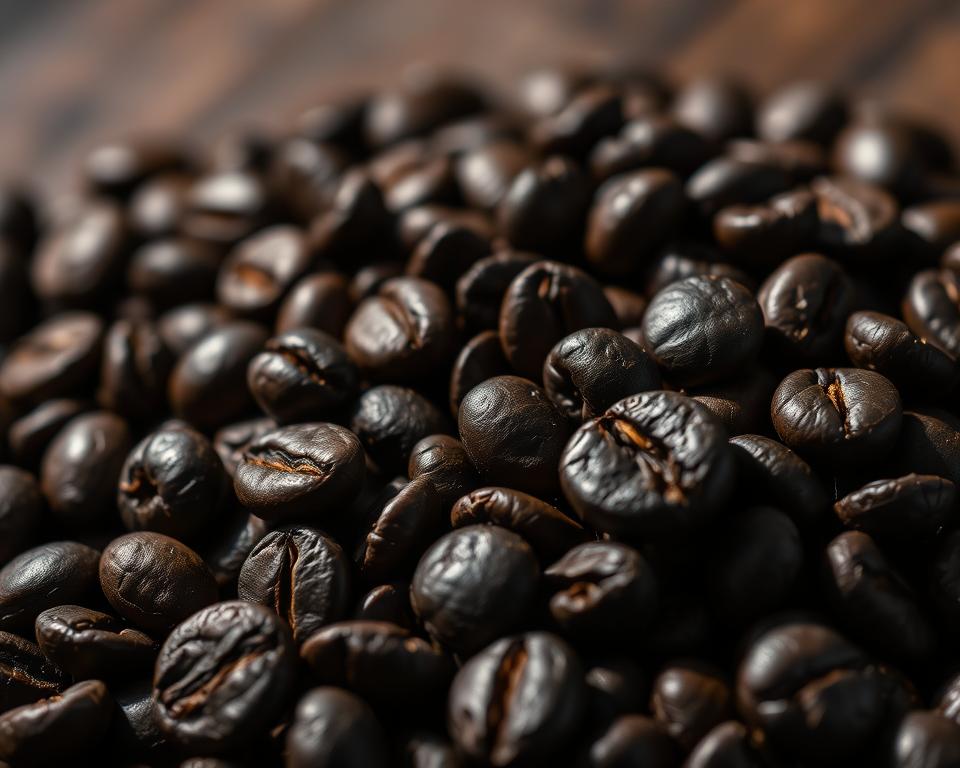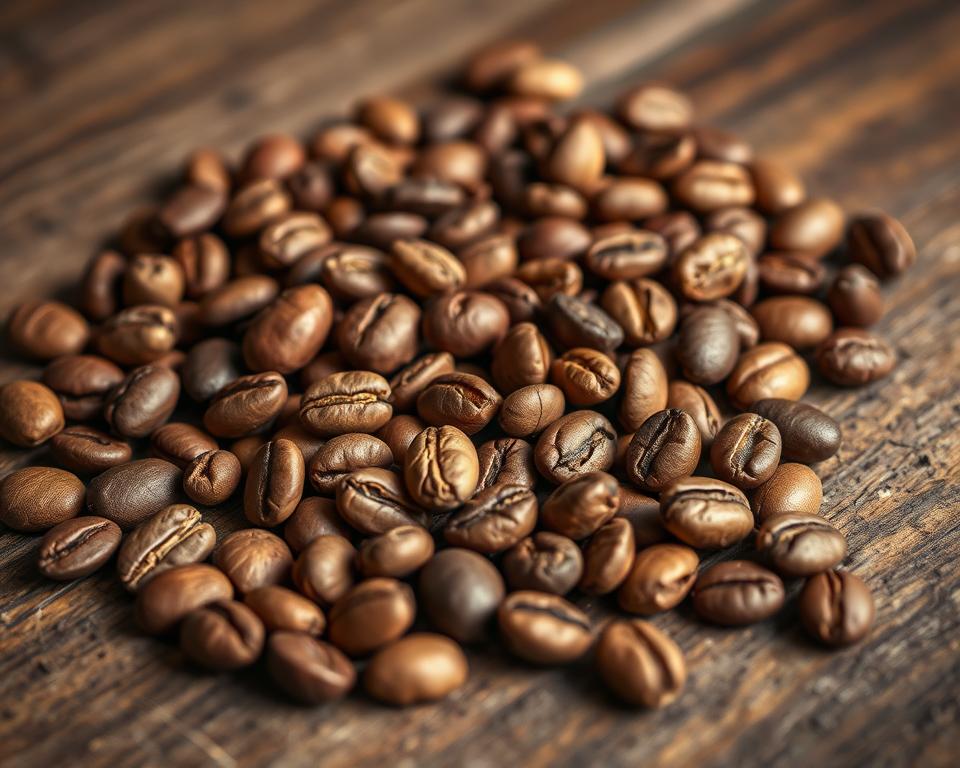Every morning, millions start their day with a comforting coffee. But what makes each cup unique? The answer lies in roast profiles, the process that transforms green beans into the brew in your cup. Coffee bean roasting isn’t just heat and time—it’s a science of flavor. The Maillard reaction alone creates hundreds of compounds, giving beans their signature brown hues and complex aromas. From light roasts bursting with floral notes to dark roasts with smoky depth, every choice shapes your sip.
Roast flavor profiles determine whether you taste a bean’s origin or the roast’s boldness. Light roasts highlight fruity brightness, while dark roasts mute acidity for bold bitterness. Even bean size doubles as they roast, losing 15-20% of their weight, and develop flavors unique to each stage. This journey from seed to cup holds secrets every coffee lover should explore.
Key Takeaways
- Coffee beans shrink 15-20% in weight during roasting due to water loss.
- Light roasts preserve a bean’s origin flavors, like Ethiopia’s bright berries.
- The Maillard reaction drives’s coffee’s brown color and toasted aromas.
- Specialty coffees peak in flavor 2-3 days post-roast, not right after roasting.
- Dark roasts reduce acidity by up to 50%, amplifying caramelized bitterness.
Understanding Roast Profiles in Coffee
Roast profiles are the foundation of coffee’s flavor. These roaster profiles serve as recipes, using exact times and temperatures to reveal distinct tastes. Roasters, through their mastery of roasting techniques, achieve a perfect balance of acidity, sweetness, and body in each batch.
What Is a Roast Profile?
A roast profile outlines the transformation of green beans under heat. For instance, a light roast development stops right after the first crack, preserving floral notes. On the other hand, dark roasts, such as Vienna or Italian, roast longer to emphasize bittersweet or smoky flavors. Each phase in the profile significantly influences the bean’s final aroma and texture.
The Science Behind Roasting
Chemical transformations are key to flavor:
- The Maillard reaction produces nutty or caramel notes.
- Caramelization breaks down sugars, enhancing sweetness.
- Beans with higher density absorb heat quicker—roasters adjust time to prevent burning.
- Moisture-rich beans require slower roasts to avoid uneven roast development.
Processing methods also play a role: washed beans roast faster than natural processed ones, which retain sugars and need careful heat control.
Importance of Roast Profiles for Coffee Lovers
Understanding roast profiles allows you to select brews that match your taste preferences. Light roasts emphasize origin flavors, while dark roasts mute acidity. By grasping roaster profiles, you can pick beans that align with your taste—whether you prefer fruity brightness or bold smokiness. Each sip is a testament to the science and artistry behind it!
Light Roast: Bright and Fruity Flavors
Light roast coffee opens a door to a realm of vibrant flavors, untouched by the intense heat of roasting. A roast level chart reveals that light roasts are roasted at temperatures below 400°F. This approach preserves the delicate notes of the beans. It uses a roasting temperature guide to halt the beans just after the first crack, capturing their unique characteristics.
Characteristics of Light Roasts
Light roasts display a light brown color with no oil on their surface. Their bright acidity is crisp and lively. The Maillard reaction develops these flavors gently, without overpowering the bean’s origin notes. Expect to find tastes like citrus, berries, or floral hints that reflect the coffee’s origin.
Popular Light Roast Varieties
Some standout beans excel in light roasts:
- Ethiopian: Citrus and jasmine notes
- Kenyan: Bold berry flavors
- Guatemalan: Tropical fruit acidity
| Region | Flavor Notes |
|---|---|
| Ethiopia | Citrus, jasmine, hibiscus |
| Kenya | Raspberry, blackcurrant |
| Colombia | Stone fruit, caramel undertones |
Best Brewing Methods for Light Roast
Opt for brewing methods that accentuate nuanced tastes:
- Pour-over: Enhances floral aromas
- Chemex: Smooth extraction of fruit notes
- Aeropress: Balances acidity without bitterness
These methods prevent over-extraction, allowing light roasts’ natural brightness to shine. Experiment with these to discover flavors like blueberry in Ethiopian beans or almond hints in Central American batches.
Medium Roast: Balancing Sweetness and Acidity
Medium roast coffee finds a perfect balance between boldness and subtlety. It combines the distinct flavors of the bean with the skill of roasting. This middle ground in roast profiles is achieved through careful coffee roasting methods. It results in a cup that harmoniously blends bright acidity with rich sweetness. It’s ideal for those who seek complexity without the harshness of bitterness.
Medium roasts present a rich tapestry of flavors, thanks to roasting temperatures between 410°F and 430°F. Caramelized sugars contribute notes of chocolate, toffee, or toasted nuts. At the same time, they retain the unique acidity of the bean’s origin. Expect to find hints of dried fruit, spice, or a touch of berry sweetness. These beans offer a perfect balance of vibrancy and depth, making them a favorite for daily enjoyment.
- Caramel and nutty undertones
- Subtle fruit acidity paired with cocoa
- Smooth mouthfeel with medium body
Popular Medium Roast Coffees
Discover these top picks for balanced flavors:
- 100% Colombian: Full-bodied with caramel and citrus notes
- Kona Blend: Smooth with a honey-like sweetness
- Breakfast Blend: Bright and clean, with berry undertones
- Decaf Gourmet Blend (Swiss Water® process): Caffeine-free yet rich in roasted nut flavors
Brewing Tips for Medium Roast
Enhance the flavors of medium roasts with these brewing methods:
- French press: Use coarse grounds and 200°F water for nutty highlights
- Pour-over: Medium grind size to highlight acidity and sweetness
- Drip coffee makers: Perfect for everyday balanced flavor
Medium roast is incredibly versatile, adapting to individual tastes while preserving the bean’s unique story. Whether you’re new to specialty coffee or a seasoned aficionado, this roast offers a world of discovery.
Dark Roast: Bold and Intense
Dark roast coffee is known for its bold, smoky flavor. It’s made by heating the beans to high temperatures, between 435°F–445°F (224–229°C). This process gives them an oily surface and a nearly black color. Brands like Starbucks® offer dark roasts, such as Italian Roast, which have deep flavors and less acidity.

Defining Dark Roasts
Dark roasts are roasted for a longer time, which triggers Maillard reactions. These reactions caramelize sugars. Starbucks’ Dark Roast is a perfect example, with its bold body and hints of charcoal. The roast flavor profiles here focus on depth, hiding the coffee’s origin.
Common Flavor Profiles in Dark Roasts
- Rich caramel and dark chocolate tones
- Smoky, woody undertones
- Bittersweet complexity from dry distillation
“Dark roasts are like a symphony’s crescendo—bold and unapologetic.” — Starbucks Roast Master
Brewing the Perfect Dark Roast
To bring out the best in dark roasts, use espresso or French press. Use water between 195–205°F (90–96°C) and a coarse grind. This avoids bitterness. Pair it with desserts like dark chocolate truffles. A 1:16 coffee-to-water ratio keeps the flavors balanced.
How Roast Level Affects Caffeine Content
Many believe darker roasts pack more caffeine. Yet, the truth lies in the coffee bean roasting process and how beans transform during it.
The Truth About Caffeine and Roast Levels
Caffeine levels don’t increase with roasting. Instead, beans lose 15–20% of their weight as moisture evaporates. Light roasts keep more of their original compounds, while dark roasts lose mass. A study found a 20-gram portion of light roast contains 60mg caffeine, compared to 51mg in dark roast by volume. Yet, when measured by weight, the difference is less pronounced. Roasting techniques affect bean density, not caffeine content itself.
Misconceptions About Dark Roasts and Caffeine
“Dark roasts taste intense, so they must have more caffeine!”
This myth persists, but bold flavors stem from roasting, not caffeine. Dark beans lose mass, so a scoop of dark roast contains fewer beans than light roast. By volume, light roasts might even surpass dark roasts. Caffeine remains stable—roasting doesn’t significantly add or remove it.
Comparing Caffeine Levels Across Roasts
- Measurement matters: A 20g portion of any roast has similar caffeine when weighed. Scooping by volume favors lighter, denser light roasts.
- Extraction factors: Finer grinds and longer brew times pull more caffeine, regardless of roast.
- Bean type: Robusta (used in some dark roasts) has twice the caffeine of Arabica, but that’s genetics, not roasting.
Next time you brew, remember: caffeine depends more on bean type and brewing method than roast level. Choose your roast based on flavor—not caffeine myths!
Different Coffee Beans and Their Roast Profiles
The journey from bean to cup begins with understanding the impact of origin, species, and processing on roasting. Arabica and Robusta beans require unique approaches. Roast profiles must match their inherent qualities to bring out their best.

| Bean Type | Flavor Focus | Best Roast |
|---|---|---|
| Arabica | Citrus, floral, berry notes | Light to medium |
| Robusta | Earthier, nutty, chocolaty | Medium-dark to dark |
Regional beans benefit from specific roast conditions. Ethiopian beans, grown at high altitudes, are best as light roasts to showcase their tea-like brightness. Sumatran beans, on the other hand, reach their earthy depth under darker roasts.
- Colombian beans: Ideal for medium roasts to balance acidity and sweetness
- Brazilian beans: Excel in medium-dark profiles to enhance their nutty body
Processing methods also influence roast strategies. Washed beans, with their clean acidity, require shorter roasts to maintain clarity. Natural processed beans, known for their fruit-forward profiles, often need slower roasts to avoid bitterness.
Expert roasters create tailored approaches based on these factors. Next time you brew, think about how your beans’ background influences their perfect roast.
Experimenting with Roast Profiles at Home
Mastering coffee roasting methods begins with a spark of curiosity. Whether you’re using a popcorn popper, stovetop skillet, or a dedicated home roaster, each setup can unveil new flavors. A roasting temperature guide is key to precision. It helps track stages like drying (200–300°F), first crack (385°F), and second crack (435°F), which shape each bean’s potential.
Start with basic tools: a heat-resistant bowl, thermometer, and timer. A pro tip is to use a colander to cool beans quickly after roasting. Here’s how to begin:
- Preheat your device (e.g., popcorn popper) to 400°F for Ethiopian beans
- Monitor roasting temperature guide milestones like first crack timing
- Adjust airflow settings—try F2-F3 until first crack, then boost to F4
Keep a roast journal. Record batch size (400g is ideal, like for Ethiopian Guji G2), and track RoR (roast rate). A 15°F/min RoR for Costa Rica beans led to smoother results. If batches roast for 11+ minutes, reduce the time.
Experiment with development phases. Extending the development stage by 30-40 seconds can deepen chocolate notes in dark roasts. Avoid quakers? Opt for G2 beans—they’re less inconsistent than G1/G3.
After roasting, rest beans 12–24 hours. Brew and taste. Did your Kenya roast taste tropical? Adjust temps next time. With practice, even a converted Illy can produce 6-minute roasts with pro-like results. Happy roasting—your next flavor discovery is just a flame away!
Pairing Food with Different Roast Profiles
Roast flavor profiles change how coffee interacts with food. Understanding roast development is key to pairing each brew with dishes that enhance their unique tastes. Let’s explore flavor-enhancing combinations.
Light Roast Pairings
Light roasts, like Starbucks® Veranda Blend®, are known for their bright, acidic notes. Try pairing them with:
- Citrus desserts (lemon cake, key lime pie)
- Fresh berries in salads or tarts
- Buttery croissants or avocado toast to soften acidity
Medium Roast Matches
Medium roasts, such as Pike Place® Roast, offer a balance of acidity and sweetness. Pair them with:
- Nutty snacks (almond butter on toast)
- Creamy dishes (caprese salad, tomato soup)
- Spiced muffins or banana bread
Dark Roast Combinations
Rich dark roasts, like Starbucks® Espresso Roast, complement bold flavors. Pair them with:
- Dark chocolate truffles or hazelnut spreads
- Smoky dishes (BBQ ribs, chili)
- Cinnamon rolls or crème brûlée
| Roast Type | Flavor Notes | Pairing Examples |
|---|---|---|
| Light | Citrus, fruit | Lemon tart, avocado toast |
| Medium | Nutty, caramel | Almond croissants, scones |
| Dark | Chocolate, spice | Dark chocolate, chili dishes |
Experiment ly! These pairings show how roast development shapes flavor harmony. Your taste buds are the ultimate judge—mix and match to find your perfect match.
Conclusion: Discover Your Perfect Roast Profile
Finding the right roast level is akin to discovering a new favorite song. It’s all about personal taste. Whether you’re drawn to fruity notes or bold smokiness, understanding roast levels is key. This knowledge empowers every sip of coffee. Let’s summarize the essential points to guide you on your coffee journey.
Quick Guide to Roast Levels
A roast level chart makes choosing easier. Light roasts bring out floral or citrus notes, perfect for pour-over. Medium roasts offer a balance of acidity and sweetness, ideal for drip coffee. Dark roasts, on the other hand, provide bold, earthy flavors, great for espresso. Explore these profiles to find what suits your taste best.
Experiment Like a Pro
Begin with a 50g batch in a home roaster like ROEST. Adjust the charge temperature to 190°C for small batches to master coffee bean roasting. Aim for roast times between 4:30–5:30 minutes to avoid mistakes. Taste samples daily; flavor peaks 14 days post-roast. So, plan your roasting schedule with care.
Find Your Flavor Signature
Consider: Do you prefer vibrant acidity or smooth bitterness? Light roasts from Ethiopia’s floral beans or dark Indonesian blends offer contrasting flavors. The right brewing method matters too—French press for medium roasts or espresso for dark. Your perfect blend is out there, waiting to be discovered. So, explore, adjust, and enjoy the journey. Every roast has a story to tell.
FAQ
What are roast profiles in coffee?
How does roasting affect the flavor of coffee?
What are the key characteristics of light roasts?
What brewing methods are best for light roasts?
What defines a medium roast coffee?
How can I brew the perfect medium roast?
What should I know about dark roasts?
Do different roast levels affect caffeine content?
How do coffee varieties influence roast profiles?
What are some home roasting techniques?
How can I pair food with different roast profiles?

Robert Lowe is a writer at WyNeeds, where he shares his expertise and passion for coffee. With a deep appreciation for the art of brewing, he explores various coffee techniques, bean origins, and industry innovations. His engaging and informative content helps coffee lovers of all levels discover new flavors, refine their brewing skills, and stay updated on the latest trends in the coffee world.

